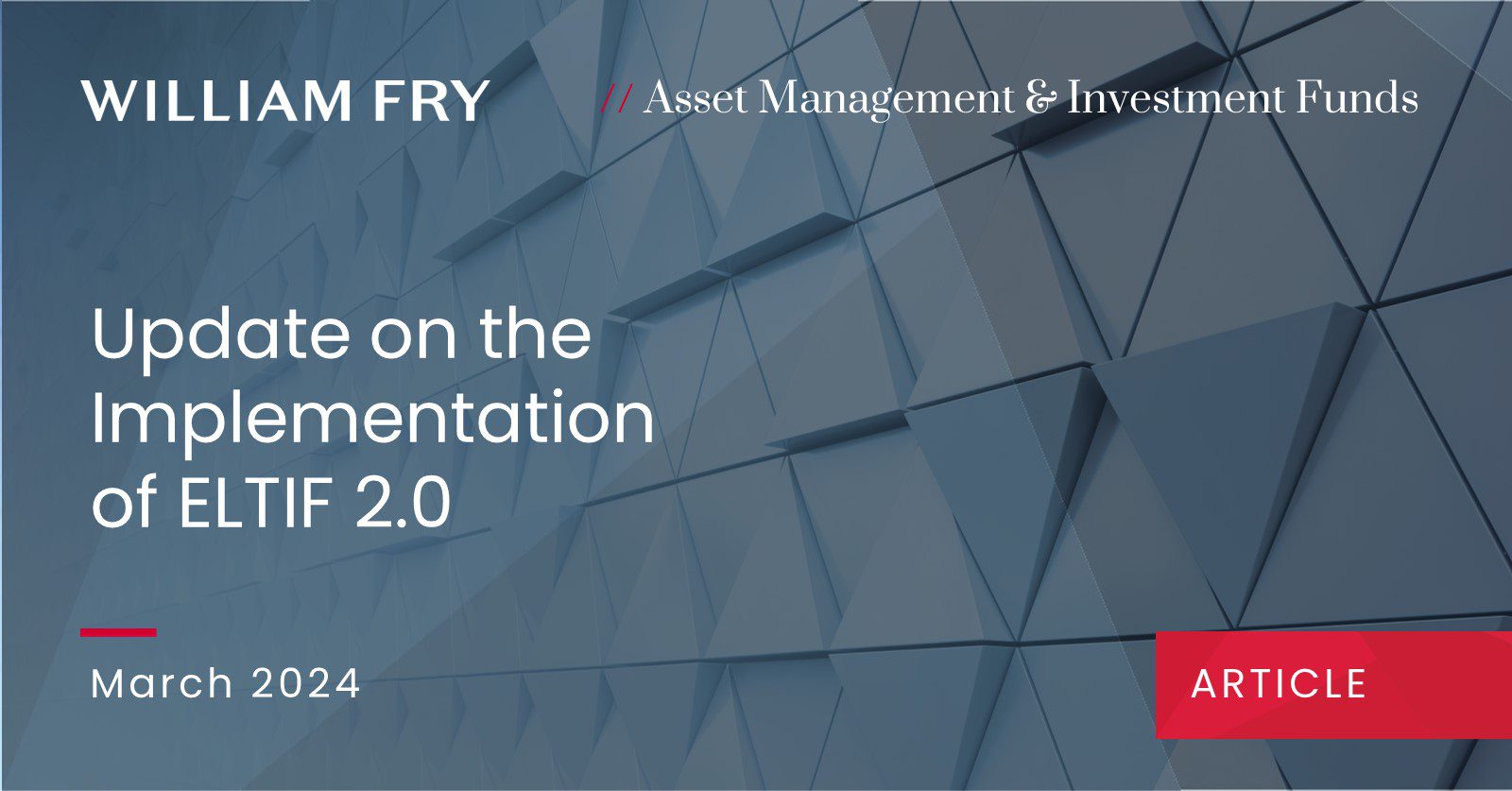This article details the steps currently taken both by the Central Bank of Ireland and at EU level to implement the amending ELTIF Regulation.
Revision of the Central Bank of Ireland’s AIF Rulebook
On 11 March 2024, the Central Bank of Ireland (CBI) published their revised AIF Rulebook which contains a dedicated ELTIF chapter. Under the revised Rulebook, ELTIFs are a discrete AIF product type separate to Ireland’s qualifying investor AIF (QIAIF) and retail investor AIF (RIAIF) product options.
Following the publication of the revised AIF Rulebook, the CBI is now in a position to authorise ELTIFs.
Some of the key elements of the new ELTIF chapter of the AIF Rulebook include:
- there will be three types of Irish ELTIF: a professional investor ELTIF, a retail investor ELTIF and a qualified investor ELTIF. In this context, the Rulebook defines “retail investor” and “professional investor” by reference to the definition of each term in the amending ELTIF Regulation. A “qualified investor” is defined as: (i) an investor who is a professional client under MiFID II; or (ii) an investor who receives an appraisal from an EU credit institution, a MiFID firm or a UCITS management company that the investor has the appropriate expertise, experience and knowledge; or (iii) an investor who certifies that they are an informed investor
- the Rulebook provides for the use of umbrella structures to establish ELTIF sub-funds, with it being possible to establish ELTIF and non-ELTIF sub-funds in the same umbrella. In this regard, existing or new RIAIF and QIAIF umbrellas will be able to incorporate retail or professional or qualified investor ELTIF and non-ELTIF sub-funds subject to certain requirements
- the QIAIF 24-hour authorisation framework will be available for professional investor and qualified investor ELTIFs. A qualified investor ELTIF which is not restricted to professional investors will be subject to the investment restrictions, portfolio composition requirements and investor protection requirements that apply to retail investor ELTIFs
Next Steps
The updates to the AIF Rulebook will meet the needs of both ELTIF investors and ELTIF sponsors, making Ireland a very attractive jurisdiction for the establishment of ELTIFs.
ESMA Regulatory Technical Standards
The amending ELTIF Regulation envisaged that ESMA would develop draft regulatory technical standards (RTS) to determine matters such as the circumstances in which the life of an ELTIF is considered compatible with the life-cycles of each of the individual assets, as well as different features of the redemption policy of the ELTIF.
On 19 December 2023, ESMA published its final report setting out the draft RTS. The following are the key provisions of the draft RTS:
Minimum holding period – the ELTIF manager may select the minimum holding period that is best adjusted to an individual ELTIF, based on criteria set in the RTS, but must justify the holding period to the ELTIF’s competent authority
Maximum redemption frequency – ESMA proposes to have a maximum quarterly redemption frequency, while allowing the ELTIF’s manager to deviate from it provided it is able to justify the deviation to the ELTIF’s competent authority
Choice of liquidity management tools – the manager of an ELTIF would be required to select at least one anti-dilution mechanism (in addition to a redemption notice period), and redemption gates, provided that the ELTIF manager could use another anti-dilution mechanism provided it is able to justify the use of that mechanism to the ELTIF’s competent authority
Notice period and maximum percentage of liquid assets that can be redeemed – the RTS contains a table which sets out the minimum percentage of liquid assets that an ELTIF must hold based on the number of days’ notice an investor must provide if it wishes to redeem its units in the ELTIF. This table also imposes a maximum percentage of liquid assets that can be redeemed on any one dealing day, again based on the ELTIF’s redemption notice period.
| Redemption Notice Period | Minimum Percentage of Liquid Assets | Maximum Percentage Referred to in Article 18(2)(d) |
|---|---|---|
| Less than 1 year to 9 months (included) | 13% | 50% |
| Less than 9 months to 6 months (included) | 27% | 45% |
| Less than 6 months to 3 months (included) | 40% | 40% |
| Less than 3 months to 1 month (included) | 40% | 35% |
| Less than 1 month | 40% | 20% |
A number of asset managers and industry bodies have raised concerns that the requirements to maintain a higher amount of liquid assets will dampen returns for ELTIF investors, making the product less commercially appealing, while the redemption restrictions could limit distribution opportunities.
Next Steps
On the date of their publication by ESMA (19 December 2023), the draft RTS were submitted to the European Commission for adoption. From the date of submission, the European Commission had three months to decide whether to adopt the RTS in whole or in part or to request changes. On 6 March 2024, the Commission sent a letter to ESMA in which the Commission outlined its intention to adopt the RTS with the following amendments:
- material changes to an ELTIF’s redemption policy should be notified to the national competent authority before they take effect, unless such material changes are beyond the control of the manager of the ELTIF.
- the draft RTS should be amended to remove the requirement for a minimum 12-month redemption notice period
- the liquidity related requirements linked to redemption notice periods requirements set out in the draft RTS should be amended and should specifically take into account the principle of proportionality, the existing market practices for retail long-term funds and the individual situation of ELTIFs
- the draft RTS should not introduce new ELTIF-specific requirements with respect to selecting and implementing liquidity management tools which are beyond those set out in Article 18(2) of the ELTIF Regulation or which otherwise limit the capacity of ELTIF managers to select and implement liquidity management tools
- the draft RTS should be amended to ensure that the implementation and activation of redemption gates is not limited to “certain specific circumstances” or exclusively contingent on the notice period set out in the calibration table proposed by the draft RTS
- the draft RTS should be amended in a manner that ensures a better alignment of the cost disclosure requirements of the ELTIF Regulation with those of the PRIIPs Regulation, MiFID and the AIFMD
ESMA now has a period of 6 weeks to amend the draft RTS on the basis of the Commission’s proposed amendments and resubmit it in the form of a formal opinion to the Commission. After the Commission has adopted the RTS it must be endorsed by the Council and Parliament of the EU. Accordingly, the RTS will likely not enter into effect until Q4 this year.
For more details, please contact John Aherne, Niall Crowley or your usual William Fry contact.




